Tea-horse Ancient Road 茶马古道 (中英双语散文)
了解茶马古道的书籍
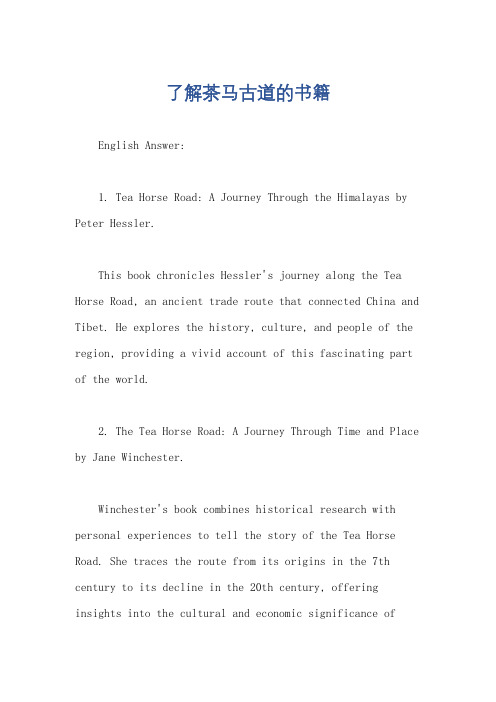
了解茶马古道的书籍
English Answer:
1. Tea Horse Road: A Journey Through the Himalayas by Peter Hessler.
This book chronicles Hessler's journey along the Tea Horse Road, an ancient trade route that connected China and Tibet. He explores the history, culture, and people of the region, providing a vivid account of this fascinating part of the world.
2. The Tea Horse Road: A Journey Through Time and Place by Jane Winchester.
Winchester's book combines historical research with personal experiences to tell the story of the Tea Horse Road. She traces the route from its origins in the 7th century to its decline in the 20th century, offering insights into the cultural and economic significance of
茶马古道写景作文400字

茶马古道写景作文400字
英文回答:
The Tea Horse Ancient Road is a breathtaking route that winds through the mountains and valleys of southwest China. As I trekked along the ancient path, I was surrounded by stunning natural scenery. The towering snow-capped peaks, lush forests, and crystal-clear streams left me in awe.
One of the most memorable moments was when I reached the famous Tiger Leaping Gorge. The sheer cliffs and roaring rapids were a sight to behold. It felt like I was standing on the edge of the world, with the powerful forces of nature all around me.
As I continued my journey, I encountered quaint
villages nestled in the mountains. The local people were warm and welcoming, and their traditional way of life was fascinating to witness. I even had the opportunity to participate in a traditional tea ceremony, where I learned
茶叶发展历程英文作文

茶叶发展历程英文作文
英文:
Tea has a long history and has undergone many changes and developments over time. In ancient times, tea was mainly used as a medicinal herb. It was not until the Tang Dynasty (618-907) that tea began to be used as a beverage. During this time, tea was also used as a tribute to the emperor. In the Song Dynasty (960-1279), tea became more popular among the common people and tea culture began to flourish.
During the Ming Dynasty (1368-1644), tea became an important export commodity. The famous tea trade route, the "Tea Horse Road," was established, which connected China with Tibet and other neighboring countries. In the Qing Dynasty (1644-1911), tea continued to be an important export and was also used as a means of payment for taxes.
英文欣赏-茶马古道
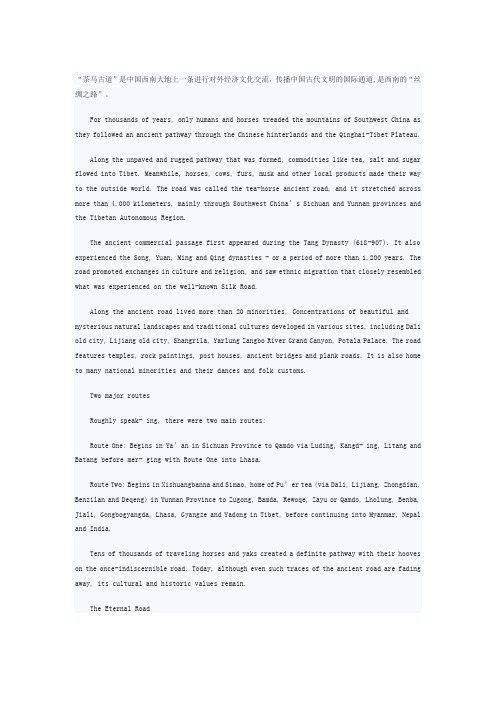
“茶马古道”是中国西南大地上一条进行对外经济文化交流,传播中国古代文明的国际通道,是西南的“丝绸之路”。
For thousands of years, only humans and horses treaded the mountains of Southwest China as they followed an ancient pathway through the Chinese hinterlands and the Qinghai-Tibet Plateau.
Along the unpaved and rugged pathway that was formed, commodities like tea, salt and sugar flowed into Tibet. Meanwhile, horses, cows, furs, musk and other local products made their way to the outside world. The road was called the tea-horse ancient road, and it stretched across more than 4,000 kilometers, mainly through Southwest China’s Sichuan and Yunnan provinces and the Tibetan Autonomous Region.
The ancient commercial passage first appeared during the Tang Dynasty (618-907). It also experienced the Song, Yuan, Ming and Qing dynasties - or a period of more than 1,200 years. The road promoted exchanges in culture and religion, and saw ethnic migration that closely resembled what was experienced on the well-known Silk Road.
优秀英语短文带翻译:茶马古道
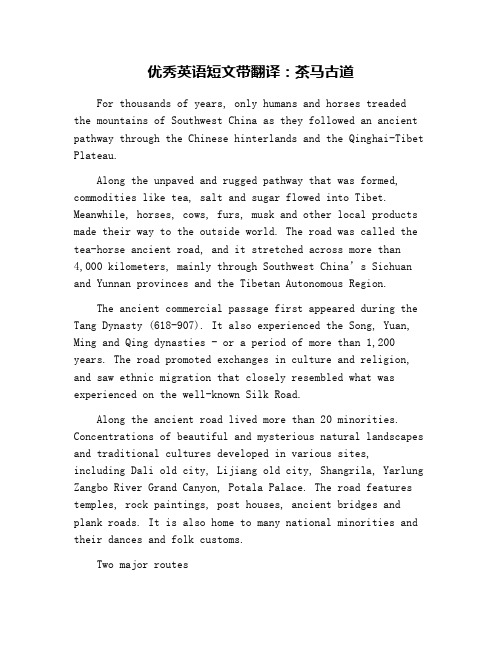
优秀英语短文带翻译:茶马古道
For thousands of years, only humans and horses treaded the mountains of Southwest China as they followed an ancient pathway through the Chinese hinterlands and the Qinghai-Tibet Plateau.
Along the unpaved and rugged pathway that was formed, commodities like tea, salt and sugar flowed into Tibet. Meanwhile, horses, cows, furs, musk and other local products made their way to the outside world. The road was called the tea-horse ancient road, and it stretched across more than
4,000 kilometers, mainly through Southwest China’s Sichuan and Yunnan provinces and the Tibetan Autonomous Region.
The ancient commercial passage first appeared during the Tang Dynasty (618-907). It also experienced the Song, Yuan, Ming and Qing dynasties - or a period of more than 1,200 years. The road promoted exchanges in culture and religion, and saw ethnic migration that closely resembled what was experienced on the well-known Silk Road.
普洱茶马古道作文写景
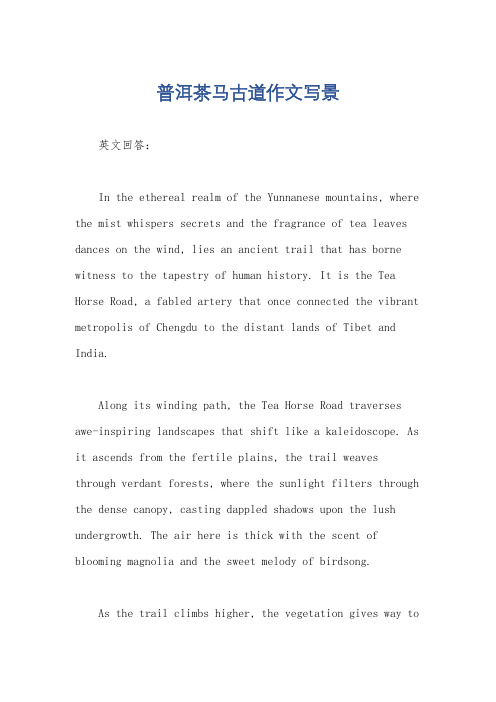
普洱茶马古道作文写景
英文回答:
In the ethereal realm of the Yunnanese mountains, where the mist whispers secrets and the fragrance of tea leaves dances on the wind, lies an ancient trail that has borne witness to the tapestry of human history. It is the Tea Horse Road, a fabled artery that once connected the vibrant metropolis of Chengdu to the distant lands of Tibet and India.
Along its winding path, the Tea Horse Road traverses awe-inspiring landscapes that shift like a kaleidoscope. As it ascends from the fertile plains, the trail weaves through verdant forests, where the sunlight filters through the dense canopy, casting dappled shadows upon the lush undergrowth. The air here is thick with the scent of blooming magnolia and the sweet melody of birdsong.
香格里拉茶马古道200字作文

香格里拉茶马古道200字作文
The ancient tea horse road in Shangri-La is a legendary route that has connected the remote region of Yunnan with Tibet for centuries. 这条古老的茶马古道位于香格里拉,是一条传奇的路线,连接了云南偏远地区和西藏数个世纪。It was used by traders to transport tea from China to Tibet on the backs of horses, creating a cultural and economic exchange between the two regions. 这条古道被商人利用,通过马匹背负茶叶从中国运输到西藏,促成了两个地区之间的文化和经济交流。
The journey along the tea horse road is not only a physical one, but also a spiritual and emotional one as well. 沿着茶马古道的旅程不仅仅是一次身体上的旅行,更是一次精神和情感上的体验。Travellers are transported back in time as they traverse the rugged terrain and experience the challenges faced by those who traveled this route centuries ago. 旅行者穿过崎岖的地形,体验数个世纪以前那些行走在这条路上所面临的挑战,仿佛被带回了过去。The sheer beauty and majesty of the landscape is awe-inspiring, and one can't help but feel a sense of reverence for the history and culture that is woven into every stone and blade of grass. 风景的绝美和壮美令人惊叹,人们不禁对每一块石头、每一根草叶中编织的历史和文化产生敬畏之情。
茶马古道路线的介绍
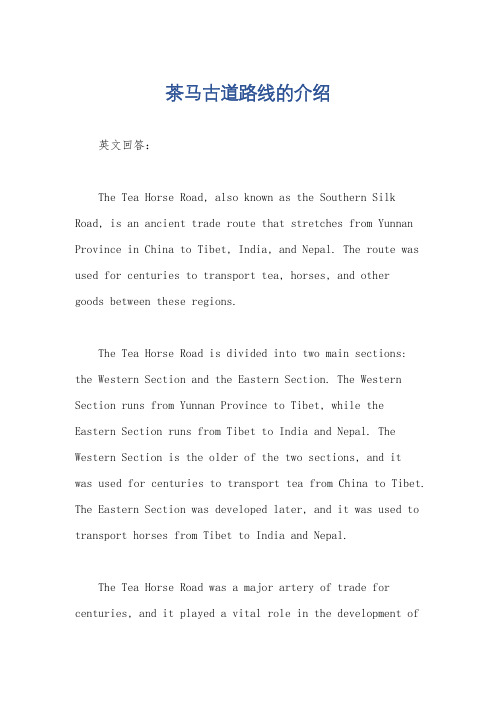
茶马古道路线的介绍
英文回答:
The Tea Horse Road, also known as the Southern Silk Road, is an ancient trade route that stretches from Yunnan Province in China to Tibet, India, and Nepal. The route was used for centuries to transport tea, horses, and other
goods between these regions.
The Tea Horse Road is divided into two main sections: the Western Section and the Eastern Section. The Western Section runs from Yunnan Province to Tibet, while the Eastern Section runs from Tibet to India and Nepal. The Western Section is the older of the two sections, and it
was used for centuries to transport tea from China to Tibet. The Eastern Section was developed later, and it was used to transport horses from Tibet to India and Nepal.
茶马古道的作文350字
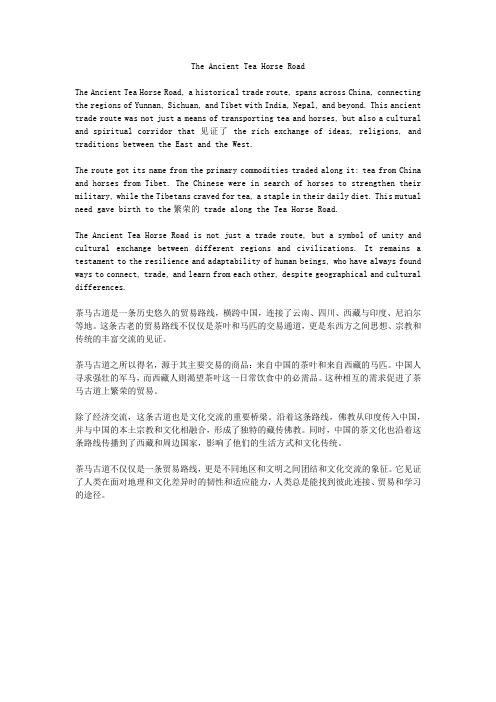
The Ancient Tea Horse Road
The Ancient Tea Horse Road, a historical trade route, spans across China, connecting the regions of Yunnan, Sichuan, and Tibet with India, Nepal, and beyond. This ancient trade route was not just a means of transporting tea and horses, but also a cultural and spiritual corridor that见证了 the rich exchange of ideas, religions, and traditions between the East and the West.
The route got its name from the primary commodities traded along it: tea from China and horses from Tibet. The Chinese were in search of horses to strengthen their military, while the Tibetans craved for tea, a staple in their daily diet. This mutual need gave birth to the繁荣的 trade along the Tea Horse Road.
茶马古道英文作文
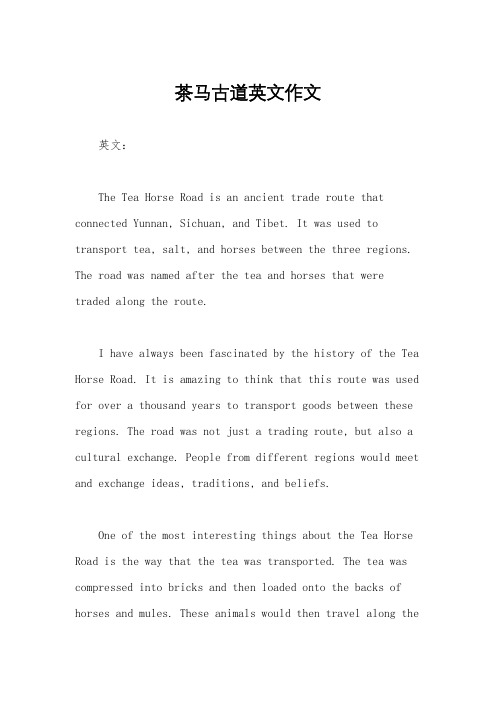
茶马古道英文作文
英文:
The Tea Horse Road is an ancient trade route that connected Yunnan, Sichuan, and Tibet. It was used to transport tea, salt, and horses between the three regions. The road was named after the tea and horses that were traded along the route.
I have always been fascinated by the history of the Tea Horse Road. It is amazing to think that this route was used for over a thousand years to transport goods between these regions. The road was not just a trading route, but also a cultural exchange. People from different regions would meet and exchange ideas, traditions, and beliefs.
One of the most interesting things about the Tea Horse Road is the way that the tea was transported. The tea was compressed into bricks and then loaded onto the backs of horses and mules. These animals would then travel along the
英语四级翻译

茶马古道(Tea-horse Ancient Road)两边,生活着20多个少数民族。不同的地方有着各自美丽而神奇的自然风景和传统文化,比如:大理,丽江古城,香格里拉(Shangrila),雅鲁藏布江大峡谷和布达拉宫(Potala Palace)。古道的两旁有庙宇、岩石壁画、骚站(post house),古桥和木板路,还有少数民族舞蹈和民族服装。时至今天,虽然这条古道的踪迹都消失了,但它的文化和历史价值仍然存在。
汉译英
Along the Tea-horse Ancient Road lived more than 20 minorities. Concentrations of beautiful and mysterious natural landscapes and traditional cultures developed in various sites,including Dali old city, Lijiang old city, Shangrila, Yarlung Zangbo River Grand Canyon, Potala Palace. The road features temples, rock paintings, post houses, ancient bridges and plank roads. It is also home to many national minorities and their dances and folk customs. Today, although the traces of the ancient road are fading away, its cultural and historic values remain.
香格里拉茶马古道200字作文
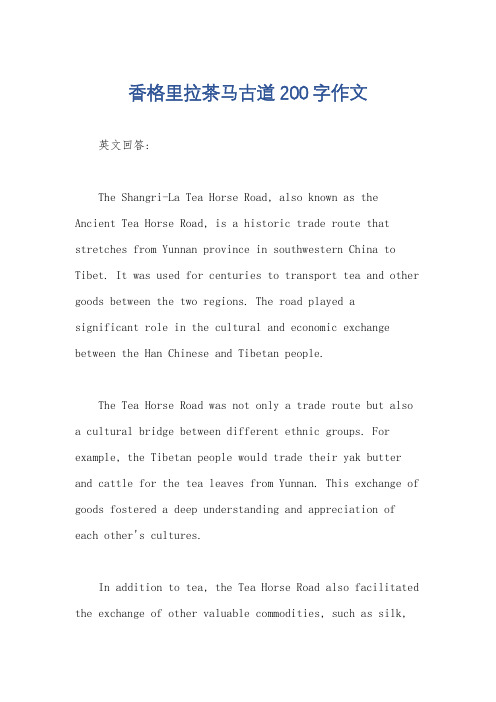
香格里拉茶马古道200字作文英文回答:
The Shangri-La Tea Horse Road, also known as the Ancient Tea Horse Road, is a historic trade route that stretches from Yunnan province in southwestern China to Tibet. It was used for centuries to transport tea and other goods between the two regions. The road played a
significant role in the cultural and economic exchange between the Han Chinese and Tibetan people.
The Tea Horse Road was not only a trade route but also a cultural bridge between different ethnic groups. For example, the Tibetan people would trade their yak butter and cattle for the tea leaves from Yunnan. This exchange of goods fostered a deep understanding and appreciation of each other's cultures.
散文朗诵《茶马古道》

茶马古道 文/我是你的太阳 诵/磊明
由一曲 西部的《茶马古道》音乐,让我随着它,走进了原始的
茶马古道,走进了历史,走进了世纪,有感而发,才有了此文 ----- ------ 引子
一只神笔,构画了一条千年的古道,这是一条通往西域的茶马古
道。它静卧在戈壁沙滩,恒亘千古,世人早以把它淡淡的遗忘。大风 吹过,还依稀可以看到马蹄的印痕。那有节奏的声音,由远而近轻轻 的传来,飘了千年,阅了万载,轻轻的留下了声音的足迹,留下了岁 月的年轮。
雨中的风铃摇动着心曲,随着骆驼有节奏的足印,回荡在空旷的
大漠,轻轻地随风送来。往事越千年,一队队商旅从这条古道走过。 远古的古道,是远古经商的栈道,这是古人追求幸福的必经之道。 这条古道记载了千万个故事,也记载着一个历史。这厚重的声音
将我们拉回到了远古,把我们带入了遥远的历史。 从荒漠的古道 ,经赤壁,栈道,潼关,我听到了马头琴的低鸣,听到了弹奏了千年 魂牵边塞的古筝曲,还听到了“咚,咚,咚咚,”紧锣密鼓的征战声
。这鼓声惊天动地,划破长空。锣声一声接着一声,一声紧似一声, 回荡在旷野的尘风中。
号声阵阵,吹响了进军的号角。这是千年经乐的奏鸣。 我看
到了古道的遗址,看到了旌旗飘飘,战旗猎猎,烈马嘶鸣。看到了铁 蹄踏过,黄沙漫天。山谷中传来的是一首震撼山峦的声音,从鬼门关 飘过,经大漠的洗涤,在山谷中穿行着,回荡着。或急促,或舒缓, 这美妙神秘的声音回荡着,永不停息。
千年的古道,在音乐声中定格回放。 月夜,大地静谧。遥望
边关冷月,星光映照着无边无垠的大漠,月色依稀映衬着被长风掩埋 古遗址的踪迹,天籁之音久久地回响。茶马古道你是一首诗,你是一 幅画,你是一条由古通今的金光大道。古道,我的千年古道,我的茶 马古道!
Tea-horse Ancient Road 茶马古道 (中英双语散文)
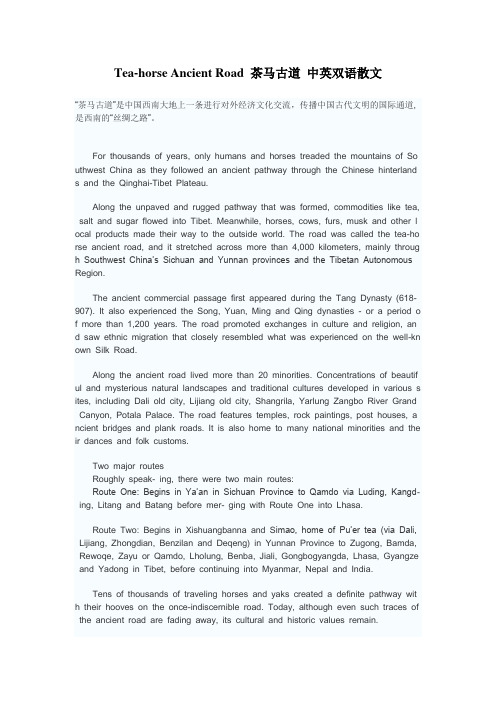
Tea-horse Ancient Road 茶马古道中英双语散文
“茶马古道”是中国西南大地上一条进行对外经济文化交流,传播中国古代文明的国际通道,是西南的“丝绸之路”。
For thousands of years, only humans and horses treaded the mountains of So uthwest China as they followed an ancient pathway through the Chinese hinterland s and the Qinghai-Tibet Plateau.
Along the unpaved and rugged pathway that was formed, commodities like tea, salt and sugar flowed into Tibet. Meanwhile, horses, cows, furs, musk and other l ocal products made their way to the outside world. The road was called the tea-ho rse ancient road, and it stretched across more than 4,000 kilometers, mainly throug h Southwest China’s Sichuan and Yunnan provinces and the Tibetan Autonomous Region.
骑马走茶马古道作文

骑马走茶马古道作文
英文回答:
Riding along the ancient Tea Horse Road is an unforgettable experience. The rugged terrain, breathtaking scenery, and rich history make it a must-visit for adventure seekers and history enthusiasts alike. The Tea Horse Road, also known as the Southern Silk Road, was a network of ancient caravan paths that stretched across the southwestern region of China, connecting the tea-producing areas of Yunnan province with Tibet and India. The road was used for trading tea, horses, and other goods, and played a significant role in the cultural exchange between different ethnic groups in the region.
The journey along the Tea Horse Road is not just about the destination, but also about the experience of traveling through time and immersing oneself in the ancient culture. Riding on horseback allows travelers to slow down and truly appreciate the beauty of the landscapes, as well as the
介绍普洱茶马古城的作文
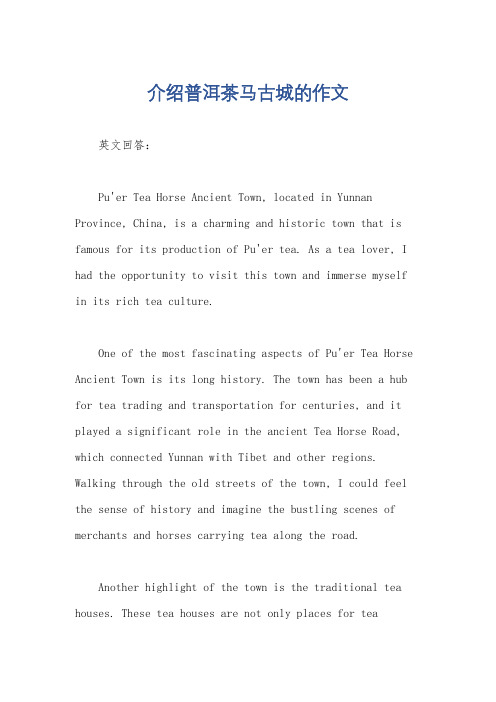
介绍普洱茶马古城的作文
英文回答:
Pu'er Tea Horse Ancient Town, located in Yunnan Province, China, is a charming and historic town that is famous for its production of Pu'er tea. As a tea lover, I had the opportunity to visit this town and immerse myself in its rich tea culture.
One of the most fascinating aspects of Pu'er Tea Horse Ancient Town is its long history. The town has been a hub for tea trading and transportation for centuries, and it played a significant role in the ancient Tea Horse Road, which connected Yunnan with Tibet and other regions. Walking through the old streets of the town, I could feel the sense of history and imagine the bustling scenes of merchants and horses carrying tea along the road.
- 1、下载文档前请自行甄别文档内容的完整性,平台不提供额外的编辑、内容补充、找答案等附加服务。
- 2、"仅部分预览"的文档,不可在线预览部分如存在完整性等问题,可反馈申请退款(可完整预览的文档不适用该条件!)。
- 3、如文档侵犯您的权益,请联系客服反馈,我们会尽快为您处理(人工客服工作时间:9:00-18:30)。
Tea-horse Ancient Road 茶马古道中英双语散文
“茶马古道”是中国西南大地上一条进行对外经济文化交流,传播中国古代文明的国际通道,是西南的“丝绸之路”。
For thousands of years, only humans and horses treaded the mountains of So uthwest China as they followed an ancient pathway through the Chinese hinterland s and the Qinghai-Tibet Plateau.
Along the unpaved and rugged pathway that was formed, commodities like tea, salt and sugar flowed into Tibet. Meanwhile, horses, cows, furs, musk and other l ocal products made their way to the outside world. The road was called the tea-ho rse ancient road, and it stretched across more than 4,000 kilometers, mainly throug h Southwest China’s Sichuan and Yunnan provinces and the Tibetan Autonomous Region.
The ancient commercial passage first appeared during the Tang Dynasty (618-907). It also experienced the Song, Yuan, Ming and Qing dynasties - or a period o f more than 1,200 years. The road promoted exchanges in culture and religion, an d saw ethnic migration that closely resembled what was experienced on the well-kn own Silk Road.
Along the ancient road lived more than 20 minorities. Concentrations of beautif ul and mysterious natural landscapes and traditional cultures developed in various s ites, including Dali old city, Lijiang old city, Shangrila, Yarlung Zangbo River Grand Canyon, Potala Palace. The road features temples, rock paintings, post houses, a ncient bridges and plank roads. It is also home to many national minorities and the ir dances and folk customs.
Two major routes
Roughly speak- ing, there were two main routes:
Route One: Begins in Ya’an in Sichuan Province to Qamdo via Luding, Kangd-ing, Litang and Batang before mer- ging with Route One into Lhasa.
Route Two: Begins in Xishuangbanna and S imao, home of Pu’er tea (via Dali, Lijiang, Zhongdian, Benzilan and Deqeng) in Yunnan Province to Zugong, Bamda, Rewoqe, Zayu or Qamdo, Lholung, Benba, Jiali, Gongbogyangda, Lhasa, Gyangze and Yadong in Tibet, before continuing into Myanmar, Nepal and India.
Tens of thousands of traveling horses and yaks created a definite pathway wit h their hooves on the once-indiscernible road. Today, although even such traces of the ancient road are fading away, its cultural and historic values remain.
The Eternal Road
No matter what is happening in the world, three types of things in the tea-hors e ancient road will continue to exist: the beautiful and rustic nature scene, inviolabl e religion and simple Tibetan people.
This ancient road features the imposing scenery and a soul-stirring quiet. Som e- times, things seem static and the sur- rounding mountains stand silent. There is a kind of beauty in the desolation that may easily lead people to believe they are experienced a prehistoric place when they visit.
The distant mountains reveal strong and exquisite ridges while rain and snow melt together, rushing down from the mountains and rapidly gathering before flowin g into innumerable rivers.
If the mountains could form a skeleton of Tibet, the resulting rivers and stream s might form their vessels, which pour vigor and vitality into the plateau.
Besides mountain and rivers, there are also many peculiar stones, incomparabl y marvelous clouds, as well as unusual light illuminating the sky as one travels the road.
Walking the tea-horse ancient road might allow one to see reverent pilgrims he ading to holy city Lhasa. They walk slowly along the rugged road, some of them e ven crawling, butting heads as they move toward their sacred destination. Their ar ms and legs fester - foreheads dripping blood - but with eyes still full of light, gran ted comfort from their beliefs.
When you walk the road of Tibet in a cloudless dawn or under the glow of a sunset, the sights can stir the senses and seem an awakening experience.
Caravans on the Way
From ancient times, mabang (caravans) have been the main vehicles used for transportation.
Year after year, thousands of cara- vans traveled the rough road while the hoo f beats and the sounds of clear bells broke the tranquility of the canyon. The road opened a vital pathway for economics and trade with the outside world.
In World War II, the tea-horse ancient road became the only transportation line for the southwest of China. Caravans trans- ported large quantities of international as-sistance from India, which greatly supported China’s Sino-Japanese War.
After the accomplishment of the Dian- Zang Highway and the Chengdu-Lhasa Highway, automobiles replaced the cara- vans, and the tea-horse ancient road be-
